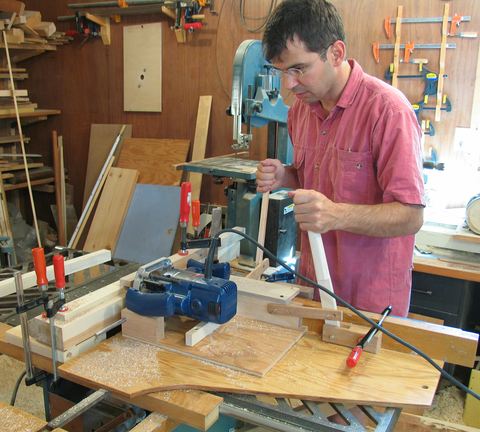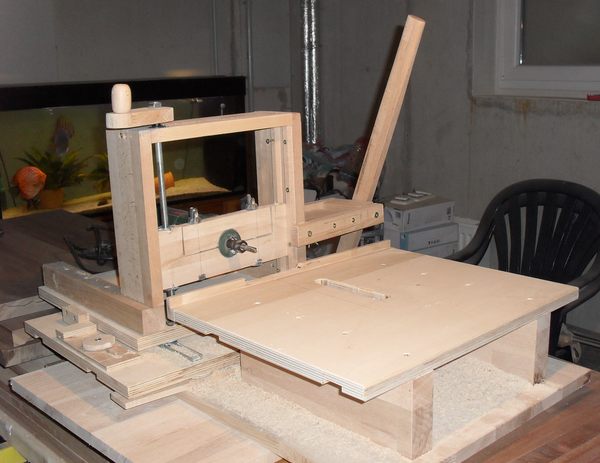Diy Slot Mortiser
- Felder Horizontal Slot Mortiser
- Diy Slot Mortiser Machine
- Griggio Slot Mortiser
- Horizontal Slot Mortiser
- Diy Slot Mortiser
- Diy Slot Mortiser Block
- Diy Slot Mortiser Tool
Messages Archive 2007
The end result is a functional horizontal slot mortiser that provides precise adjustment of the slots. The rolling cart top serves as an excellent support for boards as can be seen in the images. The other images demonstrate how accurate the slots are for loosed tenon installation.
- Consider supporting me on: This little machine will be used for cutting slotted notches on my custom door pieces.
- Wanting a slot mortiser but not willing to spend money for a commercial model, I used leftover material and spare hardware to create a simple rail-guided mortising jig for my plunge router. Despite my initial success, I further improved the jig by adding Bessey’s auto-adjust toggle clamps.
Felder Horizontal Slot Mortiser



Diy Slot Mortiser Machine
Paul Cates - Henderson, KY
>Hi everyone,
This is my first attempt at posting pictures…hope it works!
When I owned a Rojek mortiser, it was my favorite power tool, so after I sold it I decided to try to build something similar but cheaper. For the up/down adjustment, I found the following hunk of iron at a local surplus dealer for $100. It was greasy and a bit rusty, so I spent some time cleaning, sanding and repainting.
I used the 40 (mm) series 8020 linear bearings because at the time of purchase, 8020’s surplus site on eBay had both the rails and bearings in stock. The 40 series is plenty beefy, so I think the smaller sizes would work fine. The head of a 5/16” carriage bolt fits nicely into the rail slots to secure the rails to the cast table. 8020 also sells shims to make the bearings fit snugly to the rails. These are not mandatory if the bolt holes in the table are large enough to allow you to adjust the bearings to ride against the rails, but the shims are an easy way to remove slop while moving the X-Y table (vs. endless adjustments without them). DAMHIKT!
I investigated using an induction motor with a chuck attached to either the motor shaft or a mandrel, but it seemed more trouble/expense that it was worth, thus I went the router route. I made the box holding the Bosch 1617 EVS router out of plywood, with a detachable top/back. I bought the variable speed router thinking I could use it at less than full speed to cut down on the noise. It works fine, but if I had to do it over, I’d probably use a more powerful router. I can imagine a piece of red oak stopping the Bosch with a ½” bit on low speed. Rick L. gave me lots of pointers and advice via email, and I copied some of the features of Dan Barber’s Mortise-Flex (see the articles section here on WC).
The port for dust collection is on the back:
Side to side adjustments and hold downs:

Griggio Slot Mortiser
To make the lever, I bought some rod ends on eBay but couldn’t find a solid steel rod to fit through the rod end without a lot of slop. ½” was too big, so I used a 3/8” threaded rod on the inside of a hollow aluminum tube. There is a little flex in the lever, but it works fine.
I posted a video of the mortiser in action at the link below. It’s an 11mb file. The speed is set on 4 (out of 6) and I’m cutting a mortise in cherry with a two flute 3/8” end mill.
Horizontal Slot Mortiser
Messages In This Thread
- Homemade slot mortiser w/ PICS *LINK* -- Paul Cates - Henderson, KY -- 3/8/2007, 6:59 pm
- Re: Costs of 80/20 -- Rick L -- 3/12/2007, 11:06 am
- Re: Costs of 80/20 -- Paul Cates - Henderson, KY -- 3/12/2007, 3:06 pm
- Re:Shaft material -- Rick L -- 3/12/2007, 3:25 pm
- Thanks *NM* -- Paul Cates - Henderson, KY -- 3/12/2007, 7:40 pm
- Re:Shaft material -- Rick L -- 3/12/2007, 3:25 pm
- Re: Costs of 80/20 -- Paul Cates - Henderson, KY -- 3/12/2007, 3:06 pm
- Re: Homemade slot mortiser w/ PICS -- Paul Cates - Henderson, KY -- 3/11/2007, 10:32 pm
- Re: Thoughts... -- Rick L -- 3/10/2007, 10:13 pm
- Well done Paul -- HC Sakman -- 3/10/2007, 11:34 am
- Re: Well done Paul -- Paul Cates - Henderson, KY -- 3/10/2007, 6:17 pm
- BRAVO! -- Dan Barber -- 3/9/2007, 8:36 pm
- Nice job, Paul. Great dust collection. -- Eddie Pacheco, San Jose, Ca. -- 3/9/2007, 10:53 am
- Re: Homemade slot mortiser w/ PICS -- Jesse in New Mexico -- 3/9/2007, 10:27 am
- Re: Homemade slot mortiser w/ PICS -- Paul Cates - Henderson, KY -- 3/9/2007, 5:11 pm
- Nice setup Paul -- Jim Dillon -- 3/9/2007, 7:40 am
- Awesome! *NM* -- Mark Goodall - ATL - tooljunkie -- 3/9/2007, 7:03 am
- Re: Homemade slot mortiser w/ PICS -- Robert R Clough - Thorncraft -- 3/8/2007, 8:57 pm
- Paul -- Very Cool Tool! *NM* -- Paul Kramer -- 3/8/2007, 8:01 pm
- Re: Costs of 80/20 -- Rick L -- 3/12/2007, 11:06 am
Messages Archive 2007 is maintained by Ellis Walentine
Powered by Tetra-WebBBS 6.21 / TetraBB PRO 0.22 © 2006-2012 tetrabb.com
Diy Slot Mortiser
1 wallclock secs ( 0.22 usr + 0.03 sys = 0.25 CPU)
How to cut mortises accurately with a hand-held router, a straight bit, a template guide and a few scraps.
There are many ways to make mortises — and just about as many tool options. A plunge router is one of the best choices, because you can accurately control the depth of cut, and the machine delivers clean and precise results. Here’s a simple, dedicated jig you can make quickly for cutting mortises of a specific dimension with your plunge router. Its top plate has a slot to fit a template guide mounted to the router, so cutting accuracy is assured. And, a fence attached beneath the jig’s top plate provides a stout clamping surface for your workpiece, whether you secure the jig and workpiece in a bench vise or with hand clamps. Here’s how to make and use the jig.
Step 1: Since this mortising jig is dedicated to a specific-size mortise, laying out your mortised workpiece is the first step in building the jig. Everything follows from the mortise proportions. Mark the length and width of your intended mortise with a square, and extend layout lines a short distance onto the adjacent (un-mortised) faces of the workpiece to serve as reference lines later (see Photo 1).
Diy Slot Mortiser Block
Step 2: A second important piece of information you’ll need is the outside diameter (O.D.) of the screw-in template guide you’ll use in your router with this jig, as well as the diameter of the appropriate router bit. Here we’re going to use a 5/8-in. O.D. template guide around a 1/4-in. carbide spiral upcut bit. (Note: a conventional two-flute straight bit would also work fine.) The difference between the template guide’s O.D. and the router bit diameter is called the offset. You can measure it (see Photo 2), but a more accurate method to find offset is to simply subtract the bit diameter from the template guide O.D. — in our case, 5/8-in. minus 1/4-in. equals 3/8-in. of total offset. Divide this number in half to find the offset on either side of the bit; in this example, it is 3/16-in.
Step 3: For the top plate of your jig, choose a piece of 1/2-in.-thick scrap that measures 4- to 6-in. wide and about 10- to 12-in. long. Rip a strip from one edge that is exactly as wide as your template guide’s O.D. or slightly wider (see Photo 3). The strip won’t work for the jig if it is any narrower than the template guide — it establishes the width of the jig’s slot.
Step 4: Now rip the top plate of your jig in half, and crosscut the spacer strip in two. Measure the length of your mortise layout from Step 1, and add to its length the total amount of offset (in our case, 3/8-in.). This number determines the total length of the jig slot. Mark the slot locations on your top plate workpieces; centering the slot on the top plate is a good idea. Form a “sandwich” of top plate pieces and spacer strips — spread open to the overall slot length — to create the jig slot. Glue and clamp the top plate assembly together (see Photo 4). When the glue dries, trim off the excess spacer strips from the ends of the plate.
Diy Slot Mortiser Tool
Step 5: With the template guide and router bit installed in your plunge router, turn the router bottom-side up and fit the template guide’s bushing inside the jig’s slot. Plunge the router base until the bit passes through the plate so you can access it as a reference for measuring. Now use a combination square to mark long layout lines on the plate that indicate the width of the mortise. Then slide the bushing from one end of the slot to the other to mark the length of the mortise. When marking the plate, always reference from the outside edge of the router bit (see Photo 5).
Step 6: At this point, you can install the jig’s fence. To locate the fence’s position on the top plate, align the mortise “width” layout lines on your workpiece with the corresponding lines you just drew on the top plate. Draw a short layout mark on each end of the plate that’s even with the edge of your workpiece to set the fence location. You can position these layout marks either to the left or the right of the jig slot; it doesn’t matter. A bench vise can be helpful for holding the mortised workpiece steady as you align it with the plate for marking (see Photo 6).
Step 7: Select a piece of scrap several inches longer than your jig’s top plate to use for a fence. Clamp it beneath the top plate, aligned with the layout marks you drew in Step 6. Fasten the parts together with countersunk wood screws (see Photo 7). The extra fence length on each end of the plate can be helpful for clamping purposes.
Step 8: The short reference lines you drew onto the un-mortised sides of your workpiece will now come in handy for positioning it in the jig to prepare for routing (see Photo 8). Clamp the workpiece and jig together securely.
Step 9: Use the stepped turret on the router base to set up the first and subsequent depth cuts to excavate the mortise depth you need (see Photo 9). With each pass, you can either push or pull the router along the slot to clear the waste — the feed direction doesn’t matter. Make sure to remove no more than about 1/8-in. of material with each pass, especially when routing hardwood (see Photo 10, below). Use compressed air or a shop vac to keep the mortise area and jig slot clean.